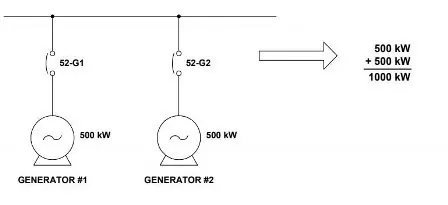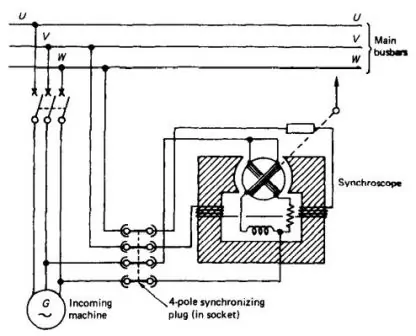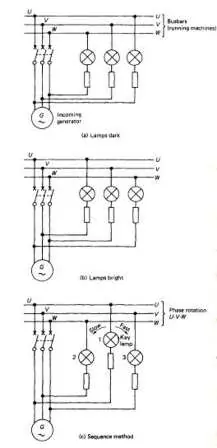Table of Contents
How to Parallel Generators
Using Multiple Generators: A Simple Guide
Generators are like backup power heroes. We have two main types: portable and standby.
Portable Generators: They save the day during power outages caused by storms and floods. They also help out on construction sites and camping trips.
Standby Generators: These are like the big heroes. They’re installed at homes or businesses and kick in automatically during power outages.
But what if you need even more power? Can you use multiple generators together? Yes, you can! It’s called “Paralleling Generators” or “Parallel Operation of Generators.” This guide will explain all the basics of how to do this. So, if you want more wattage from your generators, keep reading!
Intro
Boosting Your Generator’s Power
Imagine you got a good generator, and it worked just fine. But as time passed, you needed more power, and your old generator couldn’t keep up.
Well, you’re not alone. Many people buy slightly smaller generators, and then their power needs grow.
So, what can you do? Do you have to toss your old generator and buy a bigger, more expensive one? Not necessarily!
There’s a clever solution. You can keep using your current generator and buy a new one. Then, you run them together to get more power without breaking the bank.
It’s like having two heroes working as one team. If this idea is new to you, don’t worry; we’ll explain how to do it. Let’s dive into how to parallel generators and get that extra power you need.
What Is Generator Paralleling?



Connecting two Diesel generators in parallel to increase the power output to supply to the grid or end user is the process of paralleling generators or operating the generators in parallel mode.
In most generator applications for Parallel operation of Diesel Generators, multi-generators operate parallel to supply power to various loads.
A machine previously connected to the system is called a running machine. At the same time, the machine must be synchronized to connect, known as an incoming machine. A machine frequency reduces marginally once the active load is applied to it. An increased frequency assists it to prevent operating as a synchronous motor. A machine is not connected to the system in standstill condition since it will cause EMF in the stator winding of the machine and cause a short circuit.
If the Generators operate parallel with the grid, the grid will regulate the frequency and voltage. Generators will follow the fluctuations of voltage and frequency. Generators’ increase or decrease in output doesn’t affect the system frequency or voltage in a plant smaller than the total network size.
In Parallel mode, the generator power plant has the same operating range at full load as in island operation.
People have been doing this in big businesses for a while. Instead of having one huge generator, they use several smaller ones in parallel. Here’s why:
More Power: When your electricity needs are bigger than one generator can handle, you use two or more to get enough power.
Reliability: Teamwork makes the system more reliable and efficient than one generator alone.
Easy Maintenance: If one generator needs a break for maintenance, the others can keep the power flowing so you don’t have a complete blackout. It’s like having a backup!
Requirements for Running Generators in Parallel
- The voltage from the incoming generator and the bus bar should match instantly.
- The frequency of the incoming generator and the bus bar must be the same.
- The phase of the incoming generator should line up with the bus bar voltage.
- The phase sequence must also be the same.
These conditions must be met for a successful parallel operation.
How To Parallel Generators
Synchronizing Generators Manually



Manual Synchronization Steps:
- Start the incoming machine and let it warm up. Adjust the speed to reach the desired frequency.
- Check the incoming machine’s voltage to match the bus bar voltage.
- Make sure both machines have the same phase sequence.
- Make necessary adjustments for identical voltage, frequency, and phase sequences.
- Turn on the synchronoscope and observe the pointer’s movement.
- Stabilize the speed of the machine to the desired level.
- Keep the incoming machine’s speed slightly higher than the loaded machine to move the pointer slowly and clockwise.
- Engage the breaker before the pointer reaches 12 o’clock, indicating phase alignment.
- Decide whether to stop one machine or run them in parallel.
- Adjust speeds accordingly, decreasing the running machine’s speed while increasing the incoming machine’s speed.
- Turn off the synchroscope.
- Trip the breaker of the running machine when done.
Using a Parallel Cable Kit



How to Connect Two Generators for More Power
If you’ve got two inverter generators and want to make them work together for extra power, here’s what you need to know.
- Choose the Right Pair: Get two generators from the same brand and with the same ratings. This makes it easier to connect them.
- Check for Compatibility: Look on the front panel of the generators. You should see something like “Parallel Ready” if they can be connected.
- Get a Parallel Kit: Buy a Generator Parallel Kit from the same manufacturer as your generators. This kit has special connectors to link the generators.
- Connect with Care: Follow the instructions in your user manuals. Usually, you’ll connect the green ground connector first, then the red and black wires in that order for both generators.
- Start ‘Em Up: Once they’re connected, start both generators. Now you’ll have double the power (if they’re the same).
These steps might vary for different generators, so always check the manuals. Some models even have a specific order for turning them on, so read those user guides for precise info.
Note: This info is for India, not America.
Paralleling Three-Phase Machines Using the Lamp Method
Dark Lamp Method for Paralleling Generators:
Unlike the expensive synchroscope method, the dark lamp method is cost-effective for parallel generators. Here’s how it works:
Lamp Connection: In this method, three lamps are connected to the same phase. Using a voltmeter, two phases are linked across the bus bar and the incoming machine.
One Dark, Two Bright: In the one dark and two bright lamp system, one lamp is connected to a phase, while the other two bright lamps are connected out of phase to the bus bar.
Working Principle: When two generators are in parallel, their combined frequency is zero. Initially, when there’s a frequency difference, all three lights will stay dark. As the frequencies align, the lamps flicker together.
Incorrect Phase Sequence: If the lamps don’t flicker simultaneously, it indicates an incorrect phase sequence. In this case, stop the incoming machine and adjust the terminal connections.
Breaker Engagement: The breaker should be closed when the lamps are in the dark phase, and the net frequency is close to one. This signifies that the generators are in parallel.
Synchronization with Two Brights and One Dark Lamp Method
Here’s the procedure for synchronizing machines using the Two Brights and One Dark Lamp Method:
- Start the machine and increase its speed to the rated value.
- Connect all three lamps and a voltmeter to the terminals as shown in the image, following the Two Brights and One Dark Lamp Method.
- Compare the voltage of the incoming machine with that of the bus bar. If they are not the same, adjust the voltage of the incoming machine until it matches the terminal voltage.
- Observe the flickering of the bulbs to determine their clockwise or anticlockwise movement.
- If the bulbs move anticlockwise, the speed is slow compared to the bus bar or the running machine. If they move clockwise, it means the speed is fast.
- Adjust the speed to minimize the flickering of the bulbs until it approaches zero.
- Engage the breaker when the bulb connected to the phase is dark and the other two bright bulbs.
- Decide whether to stop one machine or run them in parallel based on your requirements and take the necessary action.
- You can achieve this by decreasing the running machine’s speed while increasing the incoming machine’s speed.
- Disconnect the power supply to the bulbs and step-down transformer.
- Trip the breaker of the running machine to complete the process.
How to Parallel Single-Phase Generators
Synchronizing a Single-Phase Generator for Parallel Operation
Synchronizing a single-phase generator for parallel operation can be achieved using dark or bright lamp synchronization. In this case, you will only need two lamps throughout the synchronization process. Here’s how it works:
- Dark Lamp Method: Connect both lamps in phase to the generator’s terminals and the bus bar.
- Bright Lamp Method: Connect the lamps out of phase with each other.
The bright lamp will flicker with alternating bright and dark phases, depending on the net frequency of the generators. When the voltage and frequency of the incoming generator match those of the operating generator, the bulb will turn black.
For synchronization, engage the breaker of the three-phase machine during the dark phase period. At this point, the two outputs are in opposition phase sequence. If the synchronization process is not executed correctly, the machines won’t synchronize, potentially leading to a reverse power trip.
Benefits of Operating Generators in Parallel
Advantages of Paralleling Generators
When you connect two generators in parallel, several advantages come your way:
- Increased Power: Paralleling two identical generators doubles your power output, allowing you to run more appliances and equipment simultaneously.
- Cost-Effective: Buying a second small generator of the same type is more economical than investing in a larger, more expensive one. Plus, you avoid the hassle of selling your old generator at a loss.
- Compact Size: Even two small generators are physically smaller and lighter than a single large generator. This benefit is especially valuable for RV owners and campers.
- Redundancy: If one generator fails, the other can keep running, providing backup power during repairs or maintenance.
- Reliability: Parallel generators share the load, reducing stress on individual units and increasing overall reliability.
- Efficiency: Smaller generators maintain high efficiency even at light loads, ensuring more efficient power usage than a large generator.
FAQ on ” How to Parallel Generators
Q: What is the parallel operation of generators?
A: It’s when multiple generators work together to provide more power.
Q: Can I connect different generator brands in parallel?
A: It’s best to use identical generators for safe parallel operation.
Q: What are the benefits of paralleling generators?
A: You get more power, cost savings, and increased reliability.
Q: How do I synchronize generators for parallel operation?
A: You can use lamps or synchronization devices to align voltage and frequency.
Blog Post Conclusion
You might have carefully selected a portable generator to meet your initial power needs, but those needs can grow over time.
When you find your current generator stretched to its limit, the solution isn’t necessarily to purchase a new and larger one. There’s a cost-effective alternative – paralleling two generators. We discussed the value of connecting generators in parallel as well as their operation in this tutorial.
Imagine you got a good generator, and it worked just fine. But as time passed, you needed more power, and your old generator couldn’t keep up.
Well, you’re not alone. Many people buy slightly smaller generators, and then their power needs grow.
So, what can you do? Do you have to toss your old generator and buy a bigger, more expensive one? Not necessarily!
There’s a clever solution. You can keep using your current generator and buy a new one. Then, you run them together to get more power without breaking the bank.
It’s like having two heroes working as one team. If this idea is new to you, don’t worry; we’ll explain how to do it. Let’s dive into how to parallel generators and get that extra power you need.
